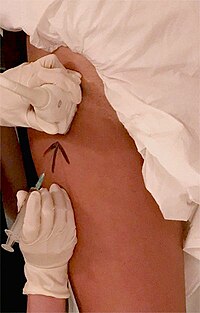
Photo from wikipedia
Dear Editor, In their recently published article on ultrasound-guided subclavian venous catheter insertion, Vezzani et al. [1] present data which include a few points of which we feel merit a… Click to show full abstract
Dear Editor, In their recently published article on ultrasound-guided subclavian venous catheter insertion, Vezzani et al. [1] present data which include a few points of which we feel merit a more precise discussion. First, the out-of-plane approach is known to be associated with a relatively high rate of posterior wall injury [2] and a high risk of pneumothorax at the subclavian site. Conversely, the in-plane approach provides a visualization of the entire needle path from skin effraction to vessel penetration and is believed to be associated with a relatively low rate of arterial injury [2]. It is therefore surprising that more arterial punctures were observed with the approach reported by Vezzani et al. [1]. This leads to the question of whether the authors assessed needle visualization during the procedure, especially when the needle tip enters the vessel? Second, confusion between the vein and the artery, proposed to explain some of the arterial punctures observed using the long axis approach, could have been easily avoided using pulsed wave Doppler ultrasound. Third, the very limited panel of investigators (n = 2) with significant mastery of the procedure makes the generalization of these results to less experienced physicians difficult. Finally, while the recently published guidelines of the Society of Critical Care Medicine support the short axis approach for ultrasound-guided venous access, this statement is only relevant for jugular and femoral sites according to the group of experts who considers the dynamic approach to be of limited value to most operators for the subclavian site (Grade 2C); instead, for the latter site the experts propose using the landmark approach [3].
Journal Title: Intensive Care Medicine
Year Published: 2017
Link to full text (if available)
Share on Social Media: Sign Up to like & get
recommendations!